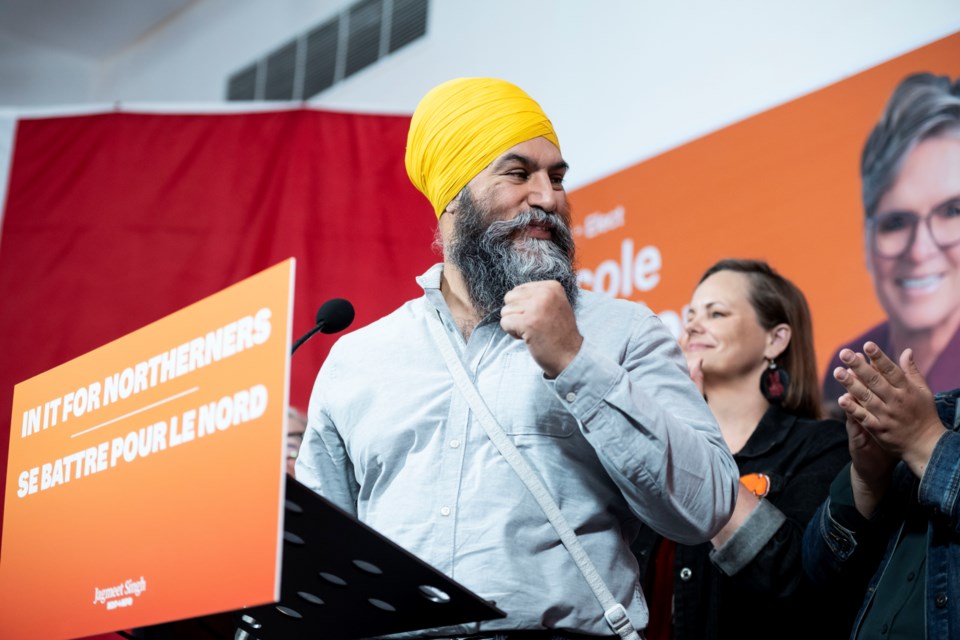NDP Leader Jagmeet Singh is looking at the success of his Ontario counterparts in the last provincial election as proof that the polls don’t always reflect New Democrat support; however, according to a polling expert, the political scenarios are very different.
Leading up to election day on Feb. 27, most provincial polling showed the Ontario Liberals about 10 points ahead of the NDP in the popular vote — and as a result, most seat-projection models predicted the New Democrats would lose their spot as the official Opposition.
In the end, the NDP did come in third in the popular vote, about 10 points behind the Liberals, but it won 27 seats to the Liberals' 14.
“It was said the New Democrats would lose party status, that the leader would lose their seat, and that didn't happen. In fact, the leader won their seat,” Singh told reporters Monday when pressed about his party’s poor polling.
“I'm pointing out specifically that, for some reason, polling doesn't seem to capture New Democrat support very well.”
It’s a comparison Singh has made multiple times when pressed about his party’s representation in the polls, which suggest support for the NDP is sitting around seven to nine per cent. Singh told reporters he has “doubts” about how pollsters cover his party, and wonders whether NDP support “is not accurately being represented.”
Kim Wright, principal of Wright Strategies and an NDP strategist, agreed with this statement, saying the polls don’t always capture undecided voters and areas where New Democrats have large concentrations.
“They frankly just aren’t able to pick up NDP incumbency and voter efficiency, so it becomes a continual source of frustration for New Democrats,” she said, adding the comparison with Ontario’s February election is a fair one.
The NDP focuses a lot of its efforts on grassroots campaigning, door-knocking and meeting voters on the ground rather than the more flashy campaigns that other political parties use to grab voters’ attention early on in the campaign, Wright said.
“There’s a lot of ground still to be made,” she said. “There are a lot of people who haven’t figured out what they are going to do.”
Founder of the poll tracking website 388 Canada, Philippe J. Fournier, said he understands why the federal NDP would make the comparison to Ontario, but while compelling, the comeback they are hoping for may not be possible.
“We have had in this campaign so far a lot of polls, including regional breakdowns, which suggest that what the Ontario NDP managed to achieve doesn't seem to be replicable for the federal level to a point,” Fournier told The Trillium.
“Would they be able to save the furniture at the expense of tanking everywhere else? That's not necessarily a positive message, but it's possible.”
He noted that while the Ontario NDP managed to maintain its seats for the most part, their vote share “really tanked.”
What was successful for the provincial party was its decision to re-focus their campaign on local candidates, particularly their incumbents.
The federal NDP “should not be trying to have a national campaign, because it’s not going anywhere,” Fournier said, noting “it would be unfathomable” if the NDP was able to win 20 seats on election day. To do so, he said, would mean abandoning all candidates outside of the ridings they hold.
“We're not talking about five, six points. We're talking about 10 or 12 points lost for the federal NDP.”
Singh has already made some messaging adjustments throughout the campaign, opting not to say he is running to be Canada’s next prime minister. Instead, he’s asking voters to elect as many New Democrats as possible.
The NDP had 24 seats in the House prior to the election.
Fournier said it’s possible that seat projections could miss a reduced swing in urban centres, but that the NDP has been “very well measured” in past polls and elections, even “overestimated.”
The one riding where the NDP could have a pickup is in Berthier-Maskinongé, Fournier said, where ex-NDP MP Ruth Ellen Brosseau is making another attempt at the seat. She held the riding from 2011 to 2019 before being ousted by Bloc MP Yves Perron.
“There were spots in Toronto, especially where the Ontario NDP did well, that the federal NDP was hoping to pick up,” he said, but added that was before former prime minister Justin Trudeau resigned, making way for a new Liberal leader in Mark Carney.
“They're not winning Davenport. They're not winning Spadina,” Fournier added. “The polling would have, not to be wrong, it would have to be incredibly wrong against the NDP, and it usually isn’t.”
Provincially, NDP Leader Marit Stiles acknowledged in a statement the NDP are “used to being the underdogs.”
“But in communities across Canada, just like here in Ontario, people know that New Democrats get results,” she said.
“That’s why there are thousands of volunteers knocking on doors to elect NDP MPs who will deliver strong local representation and stand up for what matters at this pivotal moment for Canada."




